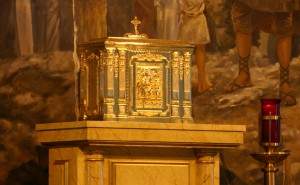Father, Today I visited a church in a nearby town in a different diocese. The Bishop in that diocese sent out a letter about a year ago that all tabernacles are to be in front of the church. This parish had the tabernacle in the back in a room all it’self and they left it there, but put another one in front. They both have a white lamp! I was with a friend from that town & he was not surprised. I wondered if that lamp is allowed to be in a white or clear glass instead of a red one.
The color of the sanctuary lamp is often red, but this isn’t prescribed anywhere. The burning lamp in many places indicates that the Eucharist is reserved there. I would say that the use of a red lamp is so common that using a different color is not a great idea. It caused confusion for you to see a white one.
In Roman churches there can be also as many as 7 lamps hanging before the tabernacle.
Another way to show that the Eucharist is present, is to have a veil on the tabernacle and/or baldachin.



































The veil and lamp together is my favorite custom. The veil says unambiguously that this is the altar with the Eucharist, and the lamp is the usual signal nowadays in these U.S.A. In Europe, I was not always 100% sure which was the Sacrament altar.
The most confusing one I’ve seen is green, though I should be happy it wasn’t just a red lightbulb with it’s own on and off switch, as I’ve seen before.
Father,
In ‘The Ceremonies of the Roman Rite Described’, page 25, footnote 20, 1983 C.I.C. 940 it reads
The glass of the lamp should be white, but coloured glass is tolerated. That is also what I remember in Rome in the 60’s, to find the blessed Sacrament look for the white oil lamp.
Thanks for all you do.
Wilky
Father, I have always understood that the Stations of the Cross had to have a cross above them. looking at the pictures of what I presume to be Stations they don’t appear to have a cross above them. Is this incorrect?
Of course sanctuary lamps are supposed to be red! That parish priest must have never read the wondrous ending of Evelyn Waugh’s novel Brideshead Revisited:
“Something quite remote from anything the builders intended has come out of their work, and out of the fierce little human tragedy in which I played; something none of us thought about at the time: a small red flame – a beaten-copper lamp of deplorable design, relit before the beaten-copper doors of a tabernacle; the flame which the old knights saw from their tombs, which they saw put out; that flame burns again for other soldiers, far from home, farther, in heart, than Acre or Jerusalem. It could not have been lit but for the builders and the tragedians, and there I found it this morning, burning anew among the old stones.
Thanks much for your answers. I am now wondering about the two tabernacles, are two allowed?! I dont think I have ever seen that in a parish church. BTW the tabernacle picture is not of the church I visited. I do have a picture if anyone wants one.
I once remembered reading on Fr. Hunwicke’s blog that white sanctuary lamps were very much part of the anglo tradition. Doesn’t surprise me, considering that tradition’s proximity to the roman one…
Ours is usually red, but is clear in Eastertime.
This bothers me, as the red is far more noticeable than the clear, especially when the wick is very low.
I wonder if cut glass would be acceptable: the refraction would give the lamp a far more festive and noticeable appearance than a plain clear cylinder.
As noted above, the lamp ought to be clear/white in color. That’s the color associated with the Eucharist and it’s feasts.
Where relics are exposed additional candles are meant to burn before such relics. Since the first relics were originally from the martyrs, it makes sense that votive lights in such a case would be red. These candles are not the same one as the sanctuary lamp.
Custom, obviously, is as important as law. Using a red sanctuary lamp is in most places a custom præter legem so certainly justifiable, and to change it without serious pastoral consideration would probably cause unnecessary confusion.
As to two tabernacles, that’s a faux pas. Generally in a single building there ought to be only a single tabernacle. Think of your great cathedrals that had a chapel especially for the Blessed Sacrament away from the main altar since Pontifical functions presume such a setup. The multiplication of tabernacles is bound to cause confusion.